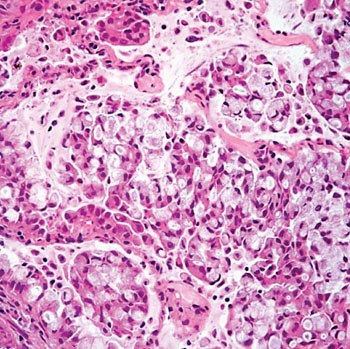Potential Lung Cancer Blood Biomarker Found
By LabMedica International staff writers
Posted on 05 Nov 2014
Patients with non-small-cell lung cancer (NSCLC) have different profiles of metabolites in their blood, suggesting there is a way to diagnose the disease from a blood sample.Posted on 05 Nov 2014
Lung cancer is the leading cause of cancer death in the USA, where every year more people die of it than of colon, breast, and prostate cancers combined and early diagnosis is the key to improving survival rates as usually symptoms do not appear until the disease is already in an advanced stage.

Image: Histopathology of pulmonary adenocarcinoma with prominent signet-ring cell features (Photo courtesy of Cesar A. Moran, MD).
Scientists at the Cleveland Clinic (Cleveland, OH, USA) examined blood samples of 284 biopsy confirmed lung cancer patients, about half men and half women, of an average age of 68 years. The patients had been diagnosed with adenocarcinoma or squamous lung cancer: 44% at stage I, 17% at stage II and 39% at stage III. The team also studied blood samples from 194 controls with the same risk profile according to age, gender, blood lipids, smoking history, and diseases like diabetes and chronic obstructive pulmonary disease (COPD), but who did not have lung cancer.
Samples were prepared and divided into two fractions, one for analysis by ultra-performance-liquid-chromatography-tandem-mass-spectrometer (UPLC-MS/MS) and one for analysis by gas chromatography–mass spectrometry (GC/MS). Compounds were identified by comparison to library entries of purified standards or recurrent unknown entities. Two-sample t-tests were used for comparison, with the level of significance adjusted for multiple comparisons. A prediction model was developed using random forest methodology.
The team identified 534 metabolites with eight metabolite super-pathways and 73 sub-pathways. The concentration of 149 metabolites differed significantly between the cancer and control groups with 70 lower and 79 higher. Reductions in phenolic compounds, elevated transculturation pathway activity, and elevations of fatty acids were particularly noteworthy. A model containing 36 metabolites was able to distinguish lung cancer from control, with a sensitivity of 70.2% and specificity of 89.5%.
The authors concluded that patients with stage I–III non-small-cell lung cancer have different serum metabolite profiles than matched controls, and that metabolite profiles point to altered lung cancer metabolic processes which may be developed into a diagnostic biomarker. The study was presented on at the annual meeting of the American College of Chest Physicians held October 25-29, 2014, in Austin (TX, USA).
Related Links:
Cleveland Clinic














